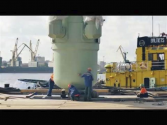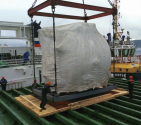Not unless they want to give the island crew some serious hazard pay, that thing looks like an accident waiting to happen.Is there a remote possibility that PLAN may ever think of building something like this? PLAN, after all, doesn't have the Suez & Panama design restriction unlike the USN as PLAN is never going to deploy Carriers in those regions.View attachment 89343
You are using an out of date browser. It may not display this or other websites correctly.
You should upgrade or use an alternative browser.
You should upgrade or use an alternative browser.
00X/004 future nuclear CATOBAR carrier thread
- Thread starter AETHER
- Start date
It's not a "fanboy drawing" but an official US Navy drawing. This particular Dual Recovery configuration was once considered during the CVN(X) Program that led to the Ford-class of Carriers.A catapult launch takes more time than a arrested landing. A good ratio is three catapults per landing strip.
We've been through all of this several times. Do we have to redo everything just because a fanboy drawing was presented?
Question:...........
At the same time, a nuclear carrier carries a lot more fuel for air ops or the escorts to use.
Does a nuclear carrier have more fuel for air operations because it is nuclear or is it because nuclear carriers are generally larger? Suppose there are two carriers of equal weight, let's say 100,000 tons. However one is nuclear powered while the other is diesel powered. Does the nuclear carrier have more jet fuel for air ops because it is not being weighed down with a large diesel fuel tank and exhaust pipes? A counter point can be made a diesel powered ship does not have to carry radiation shielding, a steam generator, and steam turbines.
What takes up more space / weight:
1) a nuclear reactor and all the components that go along with it?
2) a diesel engine / turbine and all the components that go along with it?
Uranium is 1000 times more energy dense than oil. So just consider the amount of space you will save.
The nuclear reactor isn't that large. Here is a picture of a 175MWt nuclear reactor for ships. With people next to it for comparison.
You would need like four of these to have equivalent power to the Ford class carrier.


For comparison here is one of the steam boilers in the Admiral Kuznetsov. It has 8 steam boilers. The Kuznetsov is much smaller than a Ford class carrier and a similar sized ship would need more boilers.

If you were using a steam catapult you would need to have a steam boiler in the carrier design. Now with EMALS you can use a gas turbine. This is an MT30 gas turbine as used in the QE class carrier. Which is roughly same displacement as Admiral Kuznetsov. It uses two gas turbines like this.

The gas turbines will be connected directly to a shaft. The nuclear reactor and the boiler will likely be connected to a steam turbine to do propulsion.
The nuclear reactor isn't that large. Here is a picture of a 175MWt nuclear reactor for ships. With people next to it for comparison.
You would need like four of these to have equivalent power to the Ford class carrier.


For comparison here is one of the steam boilers in the Admiral Kuznetsov. It has 8 steam boilers. The Kuznetsov is much smaller than a Ford class carrier and a similar sized ship would need more boilers.

If you were using a steam catapult you would need to have a steam boiler in the carrier design. Now with EMALS you can use a gas turbine. This is an MT30 gas turbine as used in the QE class carrier. Which is roughly same displacement as Admiral Kuznetsov. It uses two gas turbines like this.

The gas turbines will be connected directly to a shaft. The nuclear reactor and the boiler will likely be connected to a steam turbine to do propulsion.
Last edited:
Does "all the components" include the fuel? It should be included anyway. Then nuclear is likely smaller.Question:
Does a nuclear carrier have more fuel for air operations because it is nuclear or is it because nuclear carriers are generally larger? Suppose there are two carriers of equal weight, let's say 100,000 tons. However one is nuclear powered while the other is diesel powered. Does the nuclear carrier have more jet fuel for air ops because it is not being weighed down with a large diesel fuel tank and exhaust pipes? A counter point can be made a diesel powered ship does not have to carry radiation shielding, a steam generator, and steam turbines.
What takes up more space / weight:
1) a nuclear reactor and all the components that go along with it?
2) a diesel engine / turbine and all the components that go along with it?
There is another reason for nuclear that is not mentioned by other posters. The highest power output. Steam turbine (nuclear) is more powerful (per turbine) than GT. For that reason GT is not really small if you want to match the total power output. For example, Nimitz has 4 steam turbine for almost 200MW. Each turbine is 50MW. They are decade old tech. QE's MT-3 is 36MW and it is much recent tech.
Yet another reason against GT is its low efficiency at partial output such as cruising. Although this can be compensated by running reduced number of multiple engines in full power IF one uses IEPS. However, the UK has not done that well.
Last edited:
The girdle catcher in front of each catapult pegs this drawing as being likely from the 1960s or earlier.It's not a "fanboy drawing" but an official US Navy drawing. This particular Dual Recovery configuration was once considered during the CVN(X) Program that led to the Ford-class of Carriers.
Just an aside, and at the risk of sounding pedantic, most naval gas turbines (or steam turbines for that matter) are connected to a reduction gear which then actually drives the propeller shafts.Uranium is 1000 times more energy dense than oil. So just consider the amount of space you will save.
The nuclear reactor isn't that large. Here is a picture of a 175MWt nuclear reactor for ships. With people next to it for comparison.
You would need like four of these to have equivalent power to the Ford class carrier.
View attachment 89493
For comparison here is one of the steam boilers in the Admiral Kuznetsov. It has 8 steam boilers. The Kuznetsov is much smaller than a Ford class carrier and a similar sized ship would need more boilers.
View attachment 89494
If you were using a steam catapult you would need to have a steam boiler in the carrier design. Now with EMALS you can use a gas turbine. This is an MT30 gas turbine as used in the QE class carrier. Which is roughly same displacement as Admiral Kuznetsov. It uses two gas turbines like this.

The gas turbines will be connected directly to a shaft. The nuclear reactor and the boiler will likely be connected to a steam turbine to do propulsion.
The QE in particular with her Rolls-Royce MT30 engines are only part of her propulsion system, as the turbines still need to pair with a gear set, which in this case was supplied by the Swedish Dellner Group.
Question:
Does a nuclear carrier have more fuel for air operations because it is nuclear or is it because nuclear carriers are generally larger? Suppose there are two carriers of equal weight, let's say 100,000 tons. However one is nuclear powered while the other is diesel powered. Does the nuclear carrier have more jet fuel for air ops because it is not being weighed down with a large diesel fuel tank and exhaust pipes? A counter point can be made a diesel powered ship does not have to carry radiation shielding, a steam generator, and steam turbines.
I think it's a combination of both factors.
A smaller JFK conventional carrier has significantly more liquid fuel (ship fuel plus aviation fuel) than a larger nuclear Nimitz-class carrier. And I suspect a higher nuclear reactor output doesn't increase overall weight/size/cost that much. So you might as well make a larger reactor for a larger carrier.
Intrepid
Major
Is that true? If I remember correct, it is about 12.000 to 14.000 tonns for both classes.I think it's a combination of both factors.
A smaller JFK conventional carrier has significantly more liquid fuel (ship fuel plus aviation fuel) than a larger nuclear Nimitz-class carrier.
by78
General
The girdle catcher in front of each catapult pegs this drawing as being likely from the 1960s or earlier.
Was that a Freudian slip? For the record, they are called !
I'm afraid to even ask what "" are, but do they by chance have anything to do with "geosynchronized orbits"?
You see, this is precisely why I have asked you to fact-check yourself before you give in to the urge to sprinkle your saliva.
Last edited:
